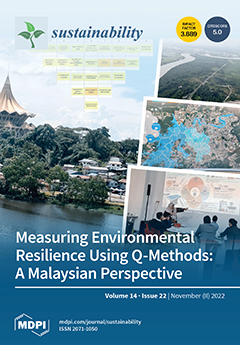In this study, the efficiency of functionalized bentonite (F-bentonite) and NiAl-layered double hydroxide (LDH), as well as their nanocomposites, was explored regarding the adsorption of cadmium ions (Cd
2+) in batch tests. Surface characterization using SEM, EDX, and FTIR analyses confirmed the
[...] Read more.
In this study, the efficiency of functionalized bentonite (F-bentonite) and NiAl-layered double hydroxide (LDH), as well as their nanocomposites, was explored regarding the adsorption of cadmium ions (Cd
2+) in batch tests. Surface characterization using SEM, EDX, and FTIR analyses confirmed the successful loading of LDH (NiAl) onto the F-bentonite and the adsorption of Cd
2+ onto the F-bentonite, LDH (NiAl), and LDH/F-bentonite composite adsorbent, suggesting ion exchange and surface precipitation as the main controlling mechanisms of the formation of adsorbent. An equilibrium contact period of 60 min was suggested, with the LDH/F-bentonite composite presenting the highest adsorption capacity and removal effectiveness as compared to the other adsorbents. The LDH/F-bentonite composite also presented the highest removal efficiency and maximum adsorption capacity at an optimum pH value of 7.0. A steady increase in the uptake capacity of Cd
2+ was observed by increasing the dosage of the adsorbents, with the LDH/F-bentonite composite having the best adsorption capacity. The fitting of the pseudo second-order kinetic model to the adsorption data of Cd
2+ suggested chemisorption on the adsorbents’ surfaces as the controlling mechanism. The Langmuir isotherm with a near-perfect fitting revealed a monolayer adsorption, while physical adsorption of Cd
2+ onto all the adsorbents is proposed using the D–R isotherm. Finally, both homogeneous and heterogeneous adsorption systems are proposed for all the adsorbents due to the satisfactory fitting of the Sips and R–P isotherm models.
Full article





